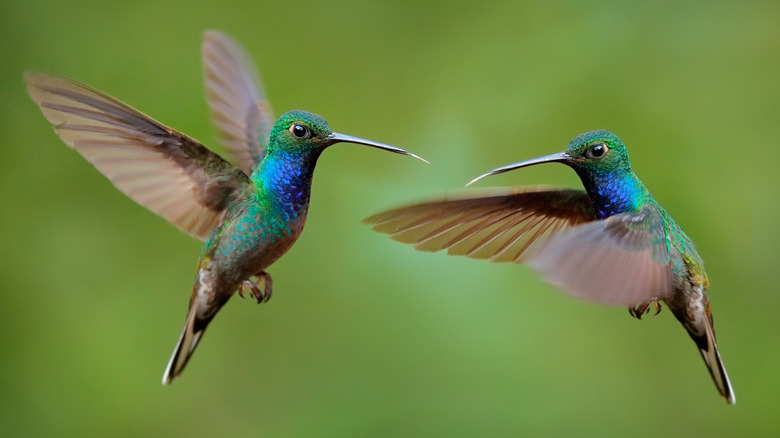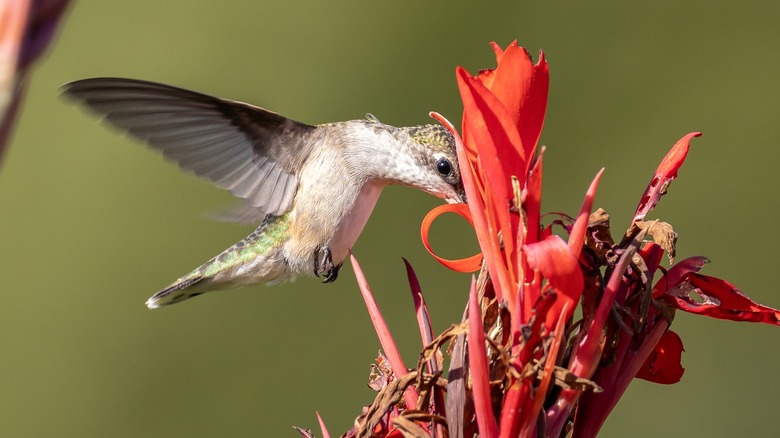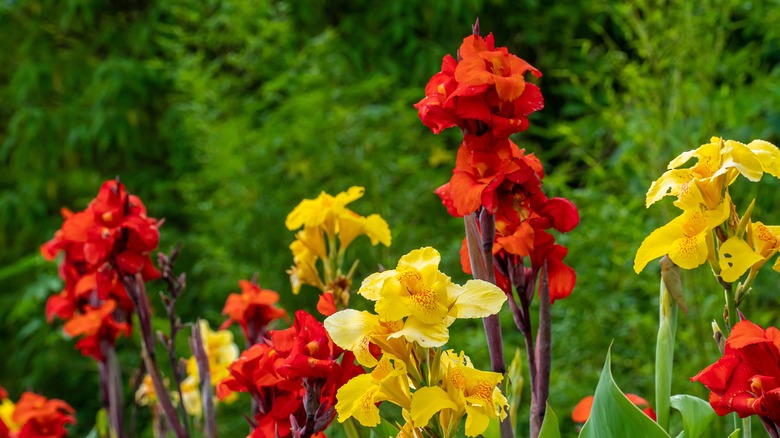Daylilies Won't Bring Hummingbirds To Your Yard, But Another Type Of Lily Might
It's easy to make the assumption that hummingbirds love all flowers, especially those with vibrant colors. Daylilies (Hemerocallis fulva) have brilliant orange and yellow flowers. They're also very easy to grow, spreading easily and coming back year after year even in chillier climates. In fact, they spread so well that in some areas, they're considered invasive. While beautiful, these flowers aren't the best option for the hummingbird lover, but canna lilies (Canna indica) will do the trick.
While they both share the name "lily" and they are both dazzling flowers that bring color to the garden, neither canna lilies nor daylilies are related to one another, or even to "true lilies." Each of these flowers is part of a separate genus and therefore has its own unique properties, and its own nutritional value to hummingbirds. Canna lilies contain large amounts of nectar, making them one of the best flowers to plant if you're trying to attract hummingbirds to your yard. Coincidentally, canna lilies are also a better choice for pet owners, since consuming daylilies and true lilies can be fatal to cats.
Why do hummingbirds love canna lilies?
Hummingbirds are drawn to canna lilies for a few key reasons. First, their bright color allows the birds to see them easily. Hummingbirds have the ability to see colors that even humans can't, and their perception of colors helps them determine which flowers contain nectar. Canna lilies come in a variety of bright colors, drawing hummingbirds in.
On top of their beckoning colors, canna lilies are also easy for hummingbirds to access because they can grow up to 8 feet tall! For the same reason that many gardeners hang hummingbird feeders high above the ground, taller flowers do a good job of attracting these winged wonders. Their height makes them easier to see and easier to drink from during a long day of flying.
Finally, canna lilies are attractive to hummingbirds because of their high nectar content. Hummingbirds have huge appetites because of their incredibly fast and near-constant activity. The Arizona State University's "Ask A Biologist" program states that hummingbirds can consume approximately half their body weight in sugar each day! While they do supplement their diet with insects, it's easy to see why hummingbirds seek out nectar-rich flowers like canna lilies.
How to grow canna lilies
If you'd like to turn your yard into a hummingbird oasis, growing canna lilies is an excellent step. Their trumpet-shaped petals and stunning range of colors add visual interest to the garden on top of benefitting pollinators like hummingbirds. These are tropical flowers and are only winter-hardy in zones seven to 11. Wait until the threat of frost has passed to plant canna lily rhizomes directly in the ground, or start them indoors in advance.
When it's time to plant your canna lilies, choose a warm, sunny spot and amend the soil with compost. You can grow and care for canna lilies in raised beds or along borders. The leaves of canna lilies can grow 6 to 12 inches wide, so they need their space. Plant rhizomes around 4 inches deep and up to 3 feet apart. Keep their soil moist without overwatering, and feed them a phosphorous-dense fertilizer to keep the gorgeous flowers coming. When you notice dead blooms, simply prune them to make way for a new one.



